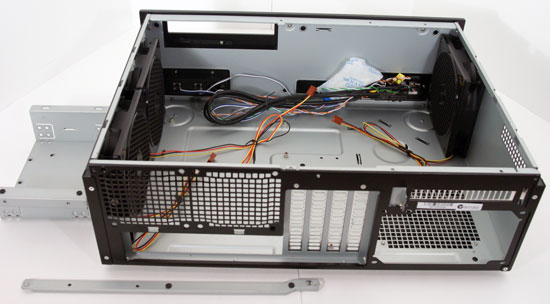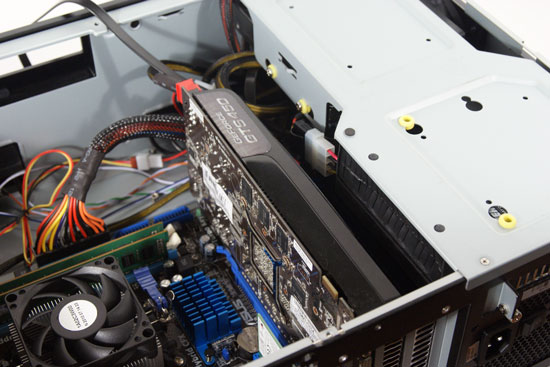SilverStone GD04 HTPC Case: Cool, Not Quiet
by Dustin Sklavos on December 25, 2010 12:00 AM EST- Posted in
- Cases/Cooling/PSUs
- HTPC
- SilverStone
- GD04
Assembling an HPTC in the GD04
When building in most cases, the assembly is fairly self-explanatory. The SilverStone GD04? Not so much. Installing my hardware in the GD04 actually resulted in my consulting the instructions that come with the case fairly frequently, and there's a reason why: SilverStone specifies a very specific order for installing components to keep cable routing fairly clean and easy.

The first thing you'll need to do is remove the trays and the crossbar, and for sanity's sake the motherboard should probably go in before the power supply does. SilverStone actually includes rubber standoffs that adhere to the bottom of the power supply, as there's a centimeter or so worth of empty space between where the unit mounts and the bottom of the case. You'll want to connect whatever cables you can and install your expansion cards, because the next step involves putting the crossbar back in.
It's at this point that you should also note the 120mm fans all come with three-pin connectors and are intended to be plugged into and controlled by the motherboard. That would be fine, but most MicroATX boards don't come with that many fan control headers (to say nothing of MiniITX), not to mention how mediocre most motherboard implementations of fan control are. SilverStone includes an adapter that allows you to plug all three headers into a single molex connector, but that also means the fans are running at full bore all the time, and you'll see why that's a problem later on. Mercifully, the fans have built-in internal grates that keep bunched up cables from getting caught in the fan blades.
After you've replaced the crossbar, you'll need to mount the hard drive or drives into the mounting tray. The tray actually supports up to three drives total: two 3.25" and a 2.5". It's probably easiest to just install one big storage drive - this is a media center case after all. The 2.5" bay does make using an SSD as an OS drive easy, however. Installing the optical drive is also pretty simple, and there's some give on it so you can line it up properly with the opening in the front. I've read that one or two users on NewEgg had to shave off part of the tray opening for their builds, but the combination Blu-ray/HD-DVD drive I have fit perfectly and without issue.

If you follow the instructions that come with the GD04, assembly actually goes fairly smoothly. The main problem is really just what a nuisance all the tiny screws can be. I understand going entirely toolless may be a convenience not available for a case this size designed for this task, but I can't help but feel like this whole ordeal could've been easier.
















68 Comments
View All Comments
RobertR13 - Saturday, December 25, 2010 - link
How can anyone choose to post noise levels, with no frame of reference? We have a bunch of pretty graphs and lot of nice numbers, but what are we supposed to compare them to? And what is the noise floor of the test area? And who on earth measures exclusively at one foot and exclusively on the side of the case? That would be like wanting to know how loud it is driving a car, and measuring sound a foot from the exhaust. You don't drive from behind the car and you don't watch movies from a foot away from the side of your computer.The writing itself isn't terrible, but a bit obviously amateurish, and the whole article is just a subjective analysis.
RobertR13 - Saturday, December 25, 2010 - link
Oh, and I nearly forgot, you can put some VERY long power supplies in this case, you just have to swap out the side fan. The side of the case is drilled for both 120mm fans(as included) and 80mm fans for those with longer power supplies who would still like some ventilation on that side of the case.8steve8 - Monday, December 27, 2010 - link
agreed, noisy compared to what?RobertR13 - Saturday, December 25, 2010 - link
I'm forced to continue making observations about this article in re-reading it.In the first paragraph the author states that he chose not to go with another case because it didn't have any vibration dampening for the optical drive bay, so he chose this case, which has no vibration dampening for the optical drive bay. Wait, what?
Also, Silverstone pretty plainly has stated in the past that the extra expansion slot above the power supply was designed for expansion cards to high end audio devices like the Emu-1212m or the Asus Xonar HDAV series with daughter cards, but that it would work with any other expansion items, like SATA or USB or what-not.
What research was one before purchasing this case?
Finally, I noticed that there is no sound measurement given with just the case fans powered up and not the CPU or GPU fans powered up, like that's not going to make a HUGE difference in the sound levels and types produced.
Hrel - Saturday, December 25, 2010 - link
he said he didn't want to have to put tape on the led on the cd drive, which is why he chose this case, read more carefully.RobertR13 - Saturday, December 25, 2010 - link
Maybe you should re-read the article, he said he chose this case over the GD-05 because he wanted to hide the LED on the ODD, but that his whole reason for looking for a new case was because his LG BD\HD-DVD drive was getting too noisy so he wanted a case with some sound dampening on the ODD bay, which this doesn't have.Stuka87 - Saturday, December 25, 2010 - link
They always measure from the same distance, this is so that all reviews that have sound levels are measured in the same way.As for frame of reference, a deciBell is a deciBell. What frame of reference do you need?
As for noise floor, any half decent tester allows you to calibrate out the ambient noise level.
RobertR13 - Saturday, December 25, 2010 - link
1: Who is they, there are no other people or cases in this article2: I'm fine with measuring from a fixed distance, but measuring from 1 foot away, from the side is rediculous.
3: dB are a standard frame of measurement, sure, but if you have a purpose built theater with a noise floor of 11dB and the case makes 36dB it is going to seem a lot louder than if you are just putting it in your family room with a noise floor of 25+dB.
4: That would invalidate the experiment all together because if you wipe out the noise floor, then you have to say so, and state what the noise floor is so that people can actually use the number for something, and two, if it screens out tones, that you are telling it to consider ambient noise, then you might be missing a specific sound frequency the fans are making.
MeanBruce - Saturday, December 25, 2010 - link
You know my floor is pretty noisy, of course that could be my neighbors downstairs.C'DaleRider - Saturday, December 25, 2010 - link
To answer your petulant, childish nitpciking, which is making you look like the 12 year old you seem to want to be noticed as,1. They are the testers at Anandtech. They have a standard set of testing requirements, such as noise checked at 1 ft. distance, to make the different testers' findings be comparable to other findings from other testers.
2. Why? If anything, it presents a worst case scenario.....the noise perception will only get better as distance increases.
3. Why worry about the floor/ambient noise? It'd only be worth noting if the ambient noise was too high to hear the noise the fans in the case generated....and then it'd be worth noting. Otherwise, once the generated noise overcomes ambient noise, the ambient noise becomes irrelevant. Noise, in this case, isn't additive.....such as adding ambient to case generated noise. Doesn't work like that.
4. Just too stupid an argument to respond to.